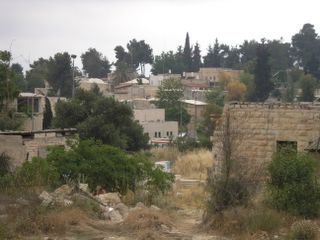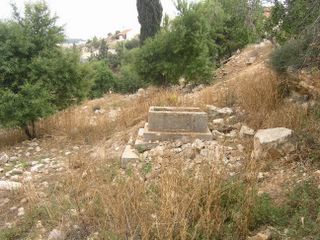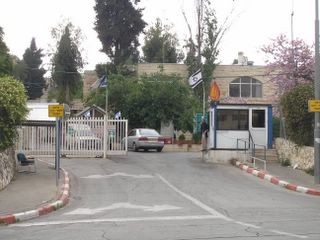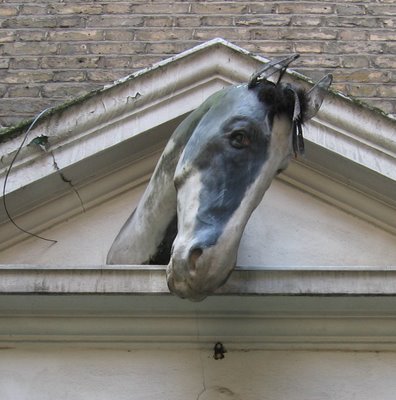Deir Yasin
I never knew where Deir Yasin was. I knew the name well: it is the village which was attacked and its people massacred by the Irgun, a Jewish militia, in April 1948. This story appears in any history of the conflict. Observers generally agree that the terrifying news of the massacre precipitated the flight of 700,000 Palestinians from their homes in towns and villages. As often with such places of History, the real Deir Yasin, a small village of stone houses and trees, soon became a symbol, an abstraction, a metaphor. From a tiny village with little importance (militarily, economically or otherwise) it became a legendary, mythological place. I always imagined it on a barren mountain top or tucked in secret valley, somewhere in the hills west of 
Deir Yasin / Kfar Sha'ul
The Deir Yasin ceremony was organised by Zochrot, a Israeli group which attempts to tell the story of the Palestinian displacement of 1948. Zochrot do a range of activities: they arrange walks to the ruins of Palestinian villages, where people tell stories and memories; they put signs (in Arabic and Hebrew) which indicate the previous names and uses of buildings and places; they hold lectures and talks about the Nakba. The group is made of Jews and Palestinians; their activities are generally made for a Jewish audience, because the story of the disaster of 1948 is rarely told in Hebrew; the Israeli public – even its ‘leftist’ side – is usually defensive and hostile when it comes to 1948.
The service was held in a little garden, overlooking the valley. It was simple, straightforward, and extremely moving. A representative of the memory committee of the village talked about their wish to build a memorial museum for the victims. She talked about the dead, who were buried in a mass grave in the valley, and how this site should be respected ‘just like the Jews are respecting and commemorating their dead victims, from Europe’; Yad Va-Shem, the
Many orthodox kids gathered around us during the ceremony. There were quite a few policemen there, in case it gets unpleasant (some events of Zochrot were attacked in the past). But nobody tried to interrupt the service. They stayed there, watching quietly, throughout the songs and the speeches.
Um Salah, an old woman who survived the massacre, slowly took her place on the stage, dressed in the traditional dress. She told her story, opening every sentence by saying ‘I pray for the Prophet’. She saw her young brother Musa, 14 years old, killed in front of her eyes; then she and her family were driven out of their homes and told to go to the Arab neighbourhoods of
Her daughter, dressed in trousers and a head scarf, spoke briefly after her, in quick sentences. ‘I just want to say that I wish we could visit the houses of the village. Everybody wants to see the place where his parents came from, she said. We heard so many stories about it … it was very different then, when people lived in villages, there was a strong solidarity between them, in times of celebration and in times of mourning. Today everybody is running around caring only for themselves’.

Some of the houses of Deir Yasin are still standing. After the war the site was turned into a mental hospital for Holocaust survivors. Yes, a mental hospital for Holocaust survivors. Whoever came up with this idea must have had an especially sick sense of humour, or an aspiration to become an existentialist playwright. It is still a mental hospital today, and the original villagers and their families are not allowed to go inside.
The exact number of the victims is unclear, but estimates run between 110 and 140. 93 names are known. ‘Worse massacres happened in
At the end of the service, the 93 names of the victims were read out. One of the people who read the names was Mordechai Vanunu, the famous ex-nuclear prisoner. He had a nice Moroccon accent, pronouncing ‘Hejj’ with a ‘French’ j. Other readers had a strong and unpleasant Israeli accent; this was perhaps the only moment of discord for me.
Afterwards I want with my friend Yoav to look for the cemetery. We crossed the road and jumped over a stone fence. We found a few shattered bomb stones down the slope, beneath the almond trees. ‘Astonishing, to think that this is it…’ said Yoav ‘the open nerves of the conflict are here. And see how it looks: just a piece of land, indistinctive, with no sign that something ever happened here, just an old tombstone and a pile of stones.’
I picked some green almonds from the tree and tasted them. It’s been years since I tasted fresh almonds, since school trips I suppose. The taste filled my mouth: sour, slightly bitter, juicy and refreshing. The almond trees of Deir Yasin: I wondered if they were there before 1948.

Strangely, the service made me optimistic. It was full of good intentions, of good will. It was refreshing in its non-official spirit. If only Israelis would stop and listen, I thought. The Palestinian women who talked at the service did not talk in grand words and in great historical pathos. They talked about the tragedy of Deir Yasin, which no one disputes. They did not seek revenge; they did not come to claim back their land. They talked about reconciliation, and about making the cemetery into a memorial site, about building a museum, about visiting the site of the village. Who could deny these simple, sensible words?
But most Israelis don’t want to listen. Any discussion of the Palestinian tragedy is seen to undermine the existence of
I don’t agree with everything Zochrot say and do, but I thought the service was touching and beautiful. And I think that both Israelis and Palestinians have to come to terms with what happened in 1948. There is no way round it, if we want to live together.
When I got to Tel Aviv that night, I noticed I lost a book by Primo Levi during the service. How annoying. Not only to lose the book, but to lose it there… I hate the way stories of the Holocaust in
On Independence Day, I want back to Deir Yasin to take some pictures. As I parked outside the mental hospital, and was looking through my camera, a small orthodox boy came on his bike and stopped next to me. He had orange sticker saying ‘Supporting the
Crazy people live inside there. He said. Why are taking pictures?
It used to be a arab village, many years ago.
Are you for the
No.
Yes.
You know, I ride a bike too, I said.
‘So how come you’re in a car?’ He wasn’t stupid.
A friend of mine went on a holiday and I’m looking after her dog, so she left me her car as well.
What’s the name of the dog?
Pancha. What’s your name?
Yaacov.
Can I take your picture?




0 Comments:
Post a Comment
<< Home